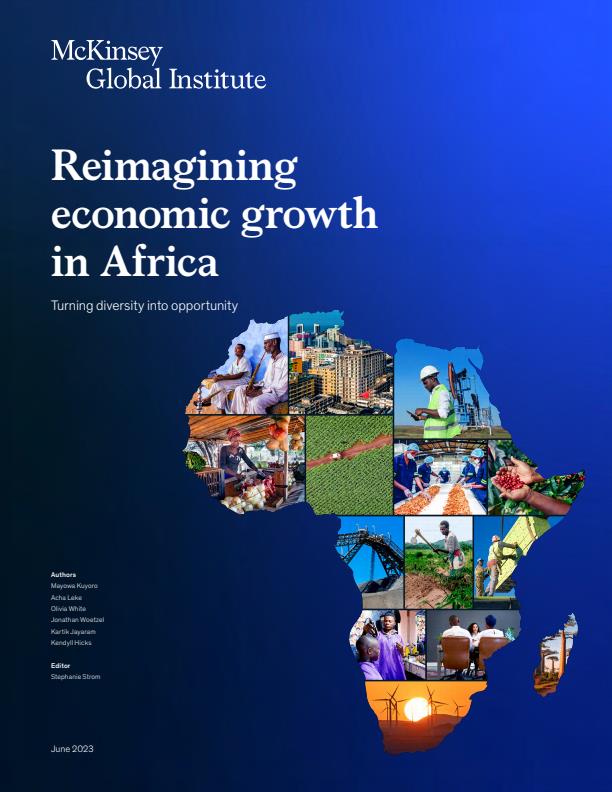Africa is home to the world’s youngest and fastest-growing population, burgeoning cities, and bold innovations in everything from fintech to clean energy. With its population expected to nearly double to 2.5 billion people by 2050, the continent presents myriad opportunities for robust, inclusive growth that harness its rich natural resources and abundant human potential to increase prosperity not only in Africa but around the world.
These strengths and assets present a chance for the continent to vastly improve its productivity and reverse the economic deceleration it endured from 2010 to 2019. GDP growth fell 35 percent over that period—and then the COVID-19 pandemic took hold, followed by the Russian invasion of Ukraine. Those events set off shifts that are still working their way through the global economy. Today, 60 percent of Africa’s population lives in poverty, the result of per capita income growth that has averaged just 1.1 percent a year for the past several decades.
Yet the continent-wide statistics obscure successes in many of its constituent countries that can serve as models to establish productivity as the foundation of Africa’s economic growth. Over the past decade, certain countries, cities, sectors, and companies have been beacons of innovation, productivity, and growth—there is no “one Africa.” In those beacons lie lessons and innovations that can reinvigorate the African economy. Our new research indicates that abundant growth and development are still possible in Africa, still happening—and, more than ever, vital for the welfare of the world.
Africa’s growth has downshifted since 2010 after a promising opening to the millennium
Africa entered the 21st century with a promising burst of economic growth that persisted for a decade before returning to the slow pace it experienced in the 1990s. From 2000 to 2010, real GDP grew at an average rate of 5.1 percent annually, up from an annual average of only 2.5 percent in the previous decade. Growth slowed to 3.3 percent per year between 2010 and 2019.
While the continent’s GDP did increase faster than its population, the absolute number of Africans living in poverty went up by 30 million. That population growth helps explain the contrast between average annual GDP per capita growth of 5 percent and 8 percent, respectively, in India and China but only 1 percent in Africa over the 30-year period from 1990 through 2019.

Image description:
Bar charts compare the compound annual growth of GDP for Africa, China, and India over three time periods: 1990 to 2000, 2000 to 2010, and 2010 to 2019. Remaining well below China's and India's rates, Africa's rate averaged 3.7%. Another set of bar charts compare the compound annual growth in population over the same time periods, and Africa stands above the other two with an average of 2.6%.
End of image description.
There is no ‘one Africa’—the continent’s recent slowdown masks divergence across countries
Almost half of Africa’s people live in countries where GDP growth between 2010 and 2019 exceeded the continent’s average growth rate of 4.2 percent since 2000. These countries, which fall into clusters we call “consistent growers” and “recent accelerators,” were largely midsize economies that benefited from higher-than-average increases in investment, exports, and urbanization, which increased productivity. These countries offer valuable models for the continent to emulate.
The other half of the African population lives in countries that grew more slowly over the past decade, including the continent’s three largest economies—Egypt, Nigeria, and South Africa—as well as ten of the smallest countries on the continent.
Together, those countries, which fall into our “recent slowdown” and “slow growers” clusters, accounted for almost 75 percent of the continent’s GDP in 2019. Increasing their productivity is imperative to restoring Africa’s economic vitality.

Image description:
A stylized pie chart plots the four country categories' share of Africa's 2019 GDP, with the recent slowdowns leading at 46%. A second chart plots the categories' share of Africa's 2019 population, with the consistent growers leading at 41% and recent slowdowns closely following at 37%.
End of image description.
Africa’s economies are shifting rapidly from agriculture and extraction to services, but productivity still lags
The African economy has undergone a profound structural shift to services over the past 20 years, as people left work in the fields to take jobs in trade and other services in cities. Reflecting that shift, employment in services increased from 30 percent to 39 percent over that period, although in 2019, half the African workforce remained in agriculture. Going forward, the continent has the human capital and resources it needs to propel growth and increase productivity across all sectors, starting with the services sector. Services have secured their place as the major driver of the continent’s economic output, contributing 56 percent in 2019 compared to 50 percent in 2000. The sector presents significant opportunities for African countries to boost economic output and job creation—but only if productivity improves. The real productivity of Africa’s services sector, at $7,200 in 2019 compared to $8,900 in India, $17,700 in Latin America, and $20,900 in China, is the lowest of any region in the world. It is critical that Africa improve the productivity not only of its services sector but also of its industrial sector. And with half of Africa’s workforce still employed in farming, boosting agricultural productivity and farmer incomes remains critical.

Image description:
A sequence of stacked bar charts plots Africa's distribution of employment over time across four sectors. Agriculture leads but shrinks from 58% in 2000 to 49% in 2019. The services sector gains the most, rising from 30% to 39% over the same period. The other two sectors, extraction and industrial, hold steady. A second sequence of stacked bar charts plot those same sectors' gross value added. Services again gains, rising from 50% to 56%, almost entirely at the expense of the extraction sector's share.
End of image description.
Improved productivity will create the jobs needed to sustain Africa’s burgeoning population
Africa will be home to the world’s largest working-age population by 2040, and smart deployment of its labor force in highly productive jobs will spur economic growth. By 2030, the services sector on its current trajectory will create at least 85 million net new jobs across the continent, enough to absorb half of new labor market entrants in highly productivity work. The number of new services jobs would almost triple if Africa matched the productivity of Asia’s strongest services hub, which would add $1.4 trillion to the continent’s economy. Additionally, agriculture remains the backbone of many African economies, accounting for 49 percent of the continent’s total employment. The agricultural sector’s productivity and output have improved steadily over the past two decades. As more people move out of agriculture and into services, Africa has opportunities to increase yields and add value to agricultural output to match the standards of global peers. Across all sectors, the trick will be to develop the skills and increase the digital tools and technologies that enable Africa’s rich pool of talent to spark and sustain productivity-led growth across the continent.

Image description:
A line chart plots the change in the working age population across six geographies from 1950 to 2020, and projected through 2050. Africa leads with a line that rises sharply from left to right, reaching above 1.5 billion in 2050. Next is India, China and Europe, which end up around 1 billion each. And below those are North America and Latin America, which end up around 500 million.
End of image description.
Imagining a more interconnected Africa
Africa trades much more with economies beyond the continent than within. Only 10 percent of its imports and 17 percent of its exports are intraregional. By contrast, in the Association of Southeast Asian Nations, or ASEAN, 21 percent of imports and 22 percent of exports are intraregional, while in Latin America, intraregional trade accounts for 19 percent of imports and 20 percent of exports. African public- and private-sector leaders can find ways to realize the potential of the African Continental Free Trade Agreement, which aims to reduce border constraints that inhibit intracontinental trade and to enhance economies of scale, competitiveness, and flows of technology and talent across borders. Agro-processing, pharmaceuticals, automotive, and logistics could deliver substantial value, but bold interventions and investment are needed to realize their potential. For example, improving transportation and logistics would require adding and improving infrastructure, reducing customers delays at borders, increasing the quantity and availability of quality trucks through financing, and scaling cold chain storage and transportation, all steps that lead to higher productivity.

Image description:
Two sets of stacked bar charts show the sources of Africa's imports and the destinations of African imports across 13 trade sectors, specially highlighting how much trade stays within Africa. Only 10% of African countries' imports come from another African country. Top sectors for intra-Africa imports are mining, food and beverages, wood and paper products, and oil and gas. Only 17% of African countries' exports go to another African country. Top sectors for intra-Africa exports include food and beverages, machinery, wood and paper products, and medical supplies and pharmaceuticals.
End of image description.
Africa is the world’s fastest urbanizing region, but depends too heavily on its primary cities
The future of Africa lies in its vibrant cities. Although 57 percent of the population lived in rural areas in 2019, the continent is urbanizing faster than any other place on the planet. Since 2000, Africa's urban population has grown 3.7 percent, outpacing overall population growth on the continent of 2.5 percent. Over the next two decades, Africa will become majority urban as more than 500 million people migrate to its cities and create the largest total number of urban dwellers in the world. By 2040, Africa will be home to 12 cities of more than ten million people each as ten more cities join Cairo and Lagos, and 19 “second” cities will have populations between five million and ten million, up from ten today.
Nonetheless, Africa has fewer and often smaller second cities than other regions of the world; among the largest cities on the continent, only four of 14 have a second city bigger than half the size of their primary cities. African primary and second cities need infrastructure investment to support businesses and workers so they can deliver the high productivity needed to increase the pace of economic growth on the continent.

Image description:
A dot plot shows a population comparison of the largest and second-largest cities in 14 African countries. The countries are shown in rows, with two circles representing the cities and a line connecting them. Cameroon is at the top with primary city Yaounde connected by a short line to second city Douala, whose population is about 90% of the size. The next closest pairs of cities are in Malawi, Ghana, Republic of Congo, and South Africa. The circle pairs get farther apart as you go downward. Adjacent is a similarly formatted chart of select non-African countries whose second cities are about 75% of the size of their primary cities: China, India, the United States, and Brazil.
End of image description.
Africa’s many large companies have been resilient—and have considerable unmet potential for growth
Large private-sector firms have an important role to play in rekindling economic progress in Africa because they contribute disproportionately to growth, innovation, employment, exports, productivity, and taxes. In Africa today, at least 345 companies have annual revenues of $1 billion or more. Collectively, they produce revenues of more than $1 trillion. The performance of large companies in Africa varied dramatically between 2015 and 2021, a period that included a global commodities downturn and the onset of the COVID-19 pandemic.
While the number of large corporations overall on the continent shrank compared to other regions and countries, Africa has nonetheless had some extremely high-performing companies across all sectors. As GDP growth recovers in many parts of the continent, large companies have considerable potential to create value by increasing their productivity. We estimate that large companies in Africa could increase their revenues collectively by more than $550 billion by 2030 with ambitious strategies to access new markets, strengthen productivity, increase operational efficiency, and play a role in society.

Image description:
A map of Africa overlays circles atop the 27 countries that have companies worth at least 1 billion dollars. The circles are sized proportionally by the number of billion-dollar companies, lia with 23, and Morocco with 20.
End of image description.
Africa has potential to unlock more than $3 trillion in consumer spending—but this will take more than a growing population
Over the past decade, certain African countries, cities, and companies have been beacons of innovation, productivity, and growth. Their successes offer models for countries on the continent where growth has been less robust. Growth can help move one billion Africans across the empowerment line, defined as the means needed to achieve self-sufficiency in basic needs such as nutrition, energy, housing, healthcare, education, and other essentials.
This would swell the ranks of the 250 million Africans who are expected to join the consuming class by 2030, unlocking $3 trillion in consumer spending. Such spending creates an opportunity for businesses to offer affordable prices at scale, target expansion in growth hot spots, and innovate in local value chains. As continent-wide growth stalled between 2010 and 2019, rising incomes accounted for only 24 percent of the increase in African consumption, while population growth drove the lion’s share, a reminder of the potential embedded in Africa’s future consumption, especially if rising income levels accompany population growth.

Image description:
A series of stacked bar charts compares Africa to other geographies by the share of their populations who consume less than $11 a day between 2000 and 2020. In Africa, about 90% of the population was in that category, falling to about 80% in 2020. In China, nearly 100% were in that category in 2000, but that dropped to 80% by 2009, matching Africa's 2020 share. In India, that group went from 90% in 2000 to 80% in 2012. In Southeast Asia, it went from 90% in 2000 to 80% in 2003. And in Latin America, that group was at 60% in 2000, already well below Africa's 2020 level.
End of image description.
Improving and increasing the productivity of all sectors must power Africa’s economic growth going forward. The continent is blessed with a young and vibrant population, rich natural resources, thriving cities, and emerging innovations, all assets that can be enlisted to enhance output and add value. Successes achieved at granular levels in countries, cities, and sectors offer models to reaccelerate growth. Increasing digitization, developing talent, collaborating more regionally, supporting more business champions, and building green businesses are just some of the ways Africa can increase productivity. The world needs a thriving Africa to make the transition to net zero, lessen the emerging impact of demographic decline, and give the continent its rightful place in global commerce and trade. Achieving sustainable growth from a foundation of strong productivity will increase African resilience and spread well-being and prosperity across the continent.


